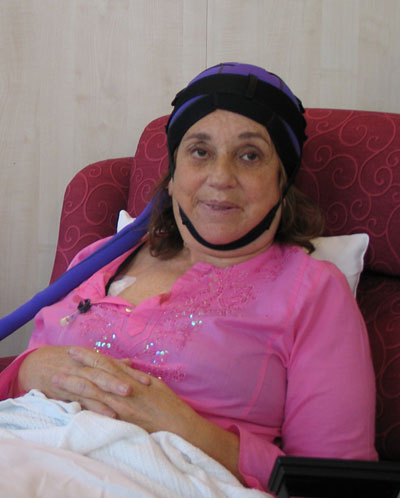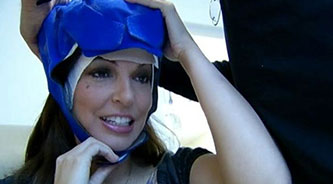Medical professionals around the world are trying out the latest scalp cooling technologies, to try and reduce one of the most challenging symptoms during the treatment of cancer. We are going to discuss many of the symptoms and treatments available for sufferers of hair loss during chemotherapy.
 Despite some of the other harrowing side effects of chemotherapy, hair loss or alopecia during chemotherapy is still one of the most distressing side effects during the treatment of cancer.
Despite some of the other harrowing side effects of chemotherapy, hair loss or alopecia during chemotherapy is still one of the most distressing side effects during the treatment of cancer.
The hair loss actually occurs as the chemotherapy does not just target the cancer cells, but affects all of the cells in the body.
Certain areas of the body are actually more susceptible and sensitive to the effects of chemotherapy. Areas such as the stomach, the lining of the mouth and the hair follicles on the scalp are usually extra sensitive to chemotherapy as cells in those areas of the body act similar to cancerous cells in the respect that they multiply more rapidly than other cells in the body.
The difference between these cells and cancerous cells is that the natural body cells will repair themselves after chemotherapy treatment which means that all side effects are temporary.
Fortunately hair loss does not occur in every course of chemotherapy treatment. The hair loss or amount of hair loss totally depends on the type of drugs you are receiving during the treatment and the levels or dosage of those particular drugs that you are receiving.
The hair loss is not instant and may occur anytime in the first few weeks after the initial course or first cycle of chemotherapy, though it may not being to happen until after receiving the second cycle treatment.
There are a few variables that may happen during chemotherapy. The hair loss can be very quick or even sudden or slow. You may lose just some of your hair or you may end up losing all of it. It usually comes out in clumps rather than gradually and it is very common for the hair loss to take place anywhere that hair grows which can include, eyebrows, eye lashes and even pubic hair.
The important thing to remember is that in almost all cases your hair will grow back after treatment has finished. It may take any where between three and six months for your hair to grow back however be prepared for your hair to possibly have a different texture colour or curl when it does eventually grow back.
So what methods are available to help prevent hair loss during chemotherapy, or at least reduce the loss of hair?
It is important to remember that none of the commercially available over the counter hair loss products are going to prevent the loss of hair during hair loss. That is not to say however that reduction of hair loss can not be achieved.
One of the primary methods that is utilized during chemotherapy to prevent or limit hair loss is scalp cooling.
Scalp cooling works by lowering the temperature of the scalp prior to, during and after the delivery of chemotherapy treatment. By reducing the temperature of the scalp we are actually reducing and restricting the blood flow around the area of the head and in turn this attempts to reduce the amount of or stop the drugs reaching the hair follicles and thus reducing or limiting hair loss.
There are a number of methods available for cooling the scalp during chemotherapy treatment; there are two primary methods that we are going to discuss however.
The first method involves using a specially designed hat which is known as a cold cap which is filled with a special type of gel that can be chilled.
The cold cap is then fitted to the head and fixed in to place by using Velcro. Despite the cap being extremely cold, it can often be heavy and is often very uncomfortable. The cap may also result in headaches. It is required to change the cap every 20 – 40 minutes in order to continue to keep the scalp cool.
The second type of scalp cooling is similar to the previous method in the respect that it requires the user to where a special cap. This method however utilizes a refrigerated cooling system to pump liquid coolant through out the cap that is joined to the system, in a similar way to how a car coolant system works.
One of the advantages of using this type of cap is that the cap is more of than not, much lighter than a standard gel filled cap. Unfortunately as the cap needs to be fitted to refrigeration system it is not possible to wander around freely as you could with a gel filled cap, though if required it is possible to disconnect the cap for short periods of time without any great increase in the temperature of the scalp.
Which ever method of scalp cooling that is chosen, you will be required to have the cap worn for a period of up to 30 to 40 minutes prior to your chemotherapy treatment session and for a period of time after the chemotherapy.
You will most likely feel cold during the treatment and you may end up needing to wear the cap for a period of anything up to a few hours which may prove to be uncomfortable, but a small price to pay for the maintenance of your locks.
It is almost impossible to know if the scalp cooling treatment will work until you have tried it. It is also worth baring in mind that certain chemotherapy drugs may react differently and as such the cap will not always be effective, depending upon the type of drug that has been administered.
Scalp treatment is not always a viable option and may not be offered when treating some types of cancer or when administering a certain type of drug, like wise the hospital may not actually have the facilities to provide scalp cooling however you doctor should be able to advise you if it is a viable option for you during your ongoing treatment.
For more information please see the following links:

